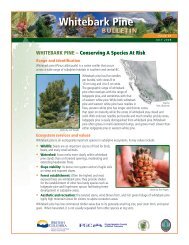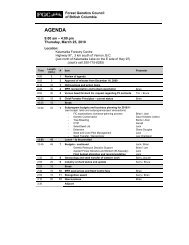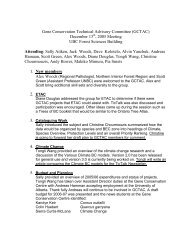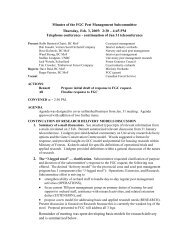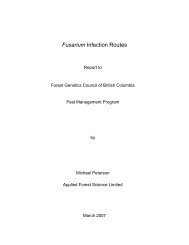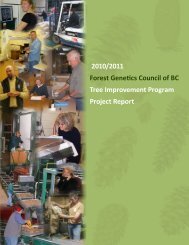Tree Improvement Program Project Report 2006 / 2007
Tree Improvement Program Project Report 2006 / 2007
Tree Improvement Program Project Report 2006 / 2007
Create successful ePaper yourself
Turn your PDF publications into a flip-book with our unique Google optimized e-Paper software.
esponse to NH 4 NO 3 acts through nutritional effects rather<br />
than directly affecting cone induction.<br />
Assuming that fertilizer does lead to improved coning<br />
response by improving the nutritional status of shoots, then<br />
it seems reasonable to assume that heavier doses of fertilizer<br />
could also improve the nutritional status of lower crown<br />
shoots in mature seed orchard trees. Under the natural<br />
inductive environment of the north Okanagan, this effect<br />
will lead to a higher coning response.<br />
To test this hypothesis, we completed the following:<br />
1. solicited the advice of Dr. Bob van den Driessche<br />
(retired research scientist and tree nutritional expert) to<br />
review the problem and make recommendations for the<br />
best fertilizer regime, the amount to apply, and the time<br />
to apply it.<br />
2. established two fertilizer trials in the MFR, Kalamalka<br />
Seed orchard 307 and the Tolko Industry Ltd, Eagle<br />
Rock Seed orchard 310 (see maps Appendix I). In June<br />
<strong>2006</strong>, two reps of each of three five-tree blocks for each<br />
of two application times (12 blocks) were selected in<br />
each of the two orchards. The three fertilizer treatments<br />
were control; NO 3 NH 4 , and a combination of fertilizers<br />
(NPK+sulphur+micros) formulated for the objectives of<br />
this experiment.<br />
3. applied fertilizer on June 28 (early) and August 31<br />
(late). The specific fertilizer formulation is shown in<br />
Table 21.<br />
4. in October, collected lower crown shoots from each<br />
of the two row sides. Shoot samples from each of 60<br />
trees and two orchards (120 in total) were shipped to<br />
the Kalamalka Seed orchards for washing and drying.<br />
Table 1<br />
T R E E I M P R O V E M E N T P R O G R A M<br />
Rate Amount per tree* per plot<br />
Fertilizer Kg/Ha Kg/Ha Kg Kg<br />
Nitrogen (NH 4NO 3) alone 100 303 0.7575 3.7875<br />
Combination<br />
N 100 303 0.7575 3.7875<br />
P 50 255 0.6375 3.1875<br />
K 50 122 0.305 1.525<br />
Ca 20 50 0.125 0.625<br />
Mg/S 10/13 50 0.125 0.625<br />
Micronutrients added to combination at 1%<br />
*note: amount per tree based on a tree spacing of 5x5m=25m<br />
P R O J E C T R E P O R T 2 0 0 6 / 2 0 0 7<br />
Dry shoot material was shipped to the Research Branch<br />
Laboratory, where nutrient analyses were completed on<br />
each of the shoot and foliage tissues.<br />
Results<br />
A summary of the mean nutrient analysis and details of<br />
fertilizer effects are available in the final report for OTIP<br />
project 4057E23 on file with the OTIP coordinator. The<br />
following is a summary of a report by Dr. R. van den<br />
Driessche (New Dendrology Inc.).<br />
Fertilizer types and time of application were both<br />
shown to affect N and S concentrations in needles at<br />
Kalamalka seed orchards. Needle concentrations of N, were<br />
higher than stem concentration at Eagle Rock, but both<br />
N and S were similar in stems and needles at Kalamalka.<br />
Potassium, Ca, and Mg did not differ much between<br />
needles and stems, but P concentration was higher in<br />
stems than in needles. Fertilization reduced needle N and<br />
S concentrations compared with control at Kalamalka, but<br />
had no effect on needle N at Eagle Rock. At Eagle Rock,<br />
needle P concentration was increased by fertilization,<br />
although only the complete fertilizer increased stem P%.<br />
The NH 4 NO 3 fertilizer may have increased the<br />
concentration of stem S (measured by combustion) at<br />
Kalamalka. Fertilizer interacted with time of application for<br />
stem N and S at Eagle Rock. Stem S showed an interaction<br />
between fertilizer and application time at Eagle Rock, in<br />
which values were higher in control at time 1 and NH 4 NO 3<br />
at time 2 (both values about 0.13), but all other treatments<br />
were about 0.11.<br />
Stem P concentrations were lower (about 0.17)<br />
at Eagle Rock than at Kalamalka (about 0.19), and<br />
although NH 4 NO 3 fertilization had no effect on stem P<br />
Total 1.95 9.75<br />
Table 21.<br />
Fert l zer<br />
formulat on.<br />
3



